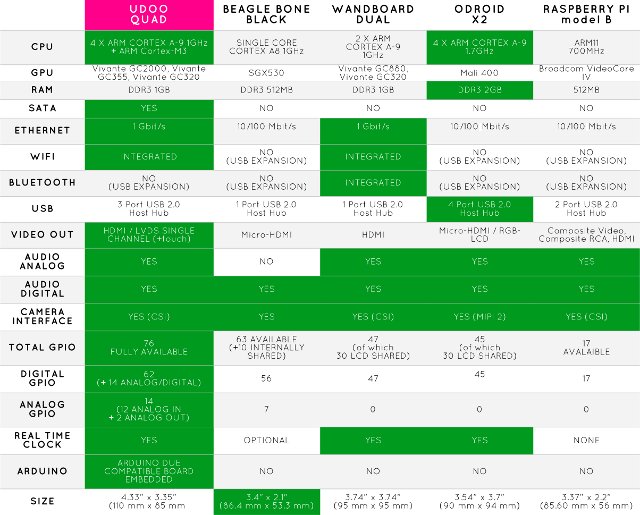UDOO QUAD is a development board featuring both Freescale i.MX 6Quad and an Atmel SAM3 Cortex M3 MCU, that’s currently having a very successful campaign on Kickstarter, as the total amount pledged is now close to $500,000 US. UDOO decided to put a comparison table against four other ARM Linux boards they consider their main competitors: the BeagleBone Black for its numerous I/O options, Wandboard Dual, also a Freescale i.MX6 powered board, the ODROID X2 for its powerful Exynos 4412 processor, and Raspberry Pi model B which is ubiquitous. The Cubieboard board would also have been an interesting addition, but they did not include it.

As you would have guessed the green parts in the tablet shows the winner for each features according to UDOO team. These 5 boards vary greatly in terms of price, and since this is not included in the table above, I’ll mention the price of the boards (excluding shipping, tax, and accessories):
- UDOO QUAD – $129
- BeagleBone Black – $45
- Wandboard Dual – $99
- ODROID X2 – $135
- Raspberry Pi – $35
Raspberry Pi and BeagleBone Black are in a different price range compared to the other three range, with the Raspberry Pi getting the crown for the cheapest board, but as usual you have to think about total cost which is project dependent. When it comes to pure processing power, ODROID X2 is probably the one you want, especially it comes with 2GB memory. If size matters to you, BeagleBone Black is the smallest board in the list, just a bit smaller than the Raspberry Pi. UDOO QUAD is the only board with SATA in the list, although Cubieboard would have been a contender here if it had been included. The Freescale boards (Udoo and Wandboard) have better connectivity options with Gigabit Ethernet, and built-in Wi-Fi, but Wandboard is the only board with built-in Bluetooth. When it comes to digital and analog I/Os, UDOO QUAD seems to outperform all other boards, even the BeagleBone Black which comes a close second.
Other useful fields would have been internal storage (UDOO as none), hardware video decoding capabilities, OS support, power consumption, etc,… but this is a never ending story.

Jean-Luc started CNX Software in 2010 as a part-time endeavor, before quitting his job as a software engineering manager, and starting to write daily news, and reviews full time later in 2011.
Support CNX Software! Donate via cryptocurrencies, become a Patron on Patreon, or purchase goods on Amazon or Aliexpress




Hi,
Thanks for all these informations.
Regarding to power consumption, do you think that thinking that we can assume that the consuption increase with CPU power ?
Or is there another considerations to take into account ?
Thanks
@Davy
From the SOC point of view, you also have to taken into account process technology, e.g. 40nm should not be as power efficient as 28nm for the same CPU architecture. The overall board power consumption depends on the system design as well. For example, Beaglebone Black may consume less than Raspberry Pi Model B: http://www.cnx-software.com/2013/04/25/beaglebone-black-vs-raspberry-pi-features-and-price-comparison/
Great overview 🙂 Could you add Parallella?
nice comparison
and nice information
thank you
I have a UDOO my self and it is great, but you can’t compare the UDOO Quad with a Wandboard Dual. Things like e.g. SATA are naturally missing on the Wandboard, because their not supported by the i.MX6 DualLite, but this would also be the case with the UDOO Dual. So to be fair, you should compare it to the Wandboard Quad.